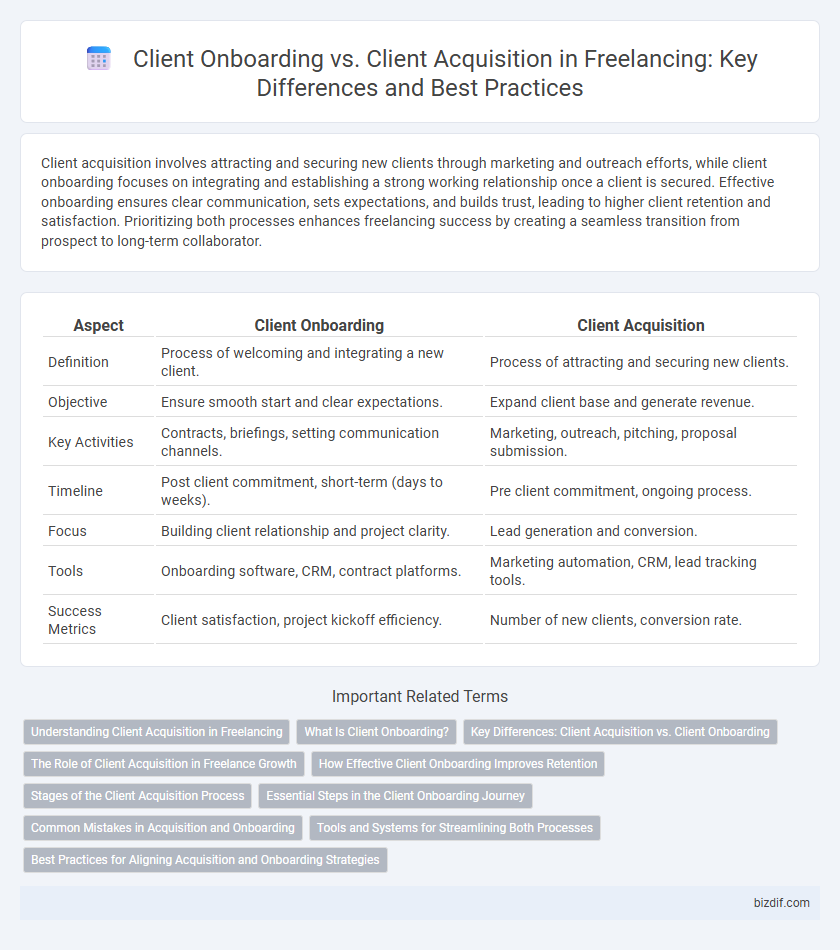Client acquisition involves attracting and securing new clients through marketing and outreach efforts, while client onboarding focuses on integrating and establishing a strong working relationship once a client is secured. Effective onboarding ensures clear communication, sets expectations, and builds trust, leading to higher client retention and satisfaction. Prioritizing both processes enhances freelancing success by creating a seamless transition from prospect to long-term collaborator.
Table of Comparison
| Aspect | Client Onboarding | Client Acquisition |
|---|---|---|
| Definition | Process of welcoming and integrating a new client. | Process of attracting and securing new clients. |
| Objective | Ensure smooth start and clear expectations. | Expand client base and generate revenue. |
| Key Activities | Contracts, briefings, setting communication channels. | Marketing, outreach, pitching, proposal submission. |
| Timeline | Post client commitment, short-term (days to weeks). | Pre client commitment, ongoing process. |
| Focus | Building client relationship and project clarity. | Lead generation and conversion. |
| Tools | Onboarding software, CRM, contract platforms. | Marketing automation, CRM, lead tracking tools. |
| Success Metrics | Client satisfaction, project kickoff efficiency. | Number of new clients, conversion rate. |
Understanding Client Acquisition in Freelancing
Client acquisition in freelancing involves the strategic process of identifying, attracting, and securing new clients through targeted marketing, networking, and portfolio showcasing. It requires freelancers to demonstrate unique value propositions and build credibility to convert prospects into paying clients effectively. Unlike client onboarding, which focuses on integrating clients post-contract, acquisition centers on expanding the freelancer's client base and generating consistent revenue streams.
What Is Client Onboarding?
Client onboarding is the process of integrating new clients into a freelancer's workflow, ensuring a smooth transition from initial agreement to project execution. It includes setting expectations, gathering project requirements, and aligning communication channels to foster a productive working relationship. Effective client onboarding enhances client satisfaction and increases the likelihood of project success and repeat business.
Key Differences: Client Acquisition vs. Client Onboarding
Client acquisition involves strategies and actions to attract and secure new clients, focusing on marketing, pitching, and closing deals. Client onboarding begins after acquisition, emphasizing the integration of clients through communication, setting expectations, and aligning project goals to ensure a smooth collaboration. The key difference lies in acquisition being customer-centric outreach, while onboarding centers on relationship-building and project initiation.
The Role of Client Acquisition in Freelance Growth
Client acquisition drives freelance growth by securing a steady stream of new projects and expanding market reach. Effective strategies such as targeted marketing, networking, and showcasing a robust portfolio attract high-value clients essential for scaling a freelance business. Seamless client onboarding then ensures retention and builds long-term professional relationships, complementing the acquisition process.
How Effective Client Onboarding Improves Retention
Effective client onboarding in freelancing sets clear expectations, streamlines communication, and builds trust, significantly enhancing client satisfaction and long-term retention. Personalized onboarding processes reduce misunderstandings and project delays, leading to smoother collaborations and higher repeat business rates. Investing in a seamless onboarding experience transforms one-time clients into loyal advocates, driving sustained freelance growth.
Stages of the Client Acquisition Process
Client acquisition involves multiple stages including lead generation, prospect qualification, proposal submission, and contract negotiation, each designed to convert prospects into paying clients. Client onboarding follows acquisition and focuses on integrating new clients through project kick-off, expectation setting, and establishing communication protocols. Effective transition between client acquisition and onboarding ensures a seamless experience that boosts client retention and satisfaction.
Essential Steps in the Client Onboarding Journey
Client onboarding involves essential steps such as setting clear expectations, gathering project requirements, and establishing communication channels to ensure a smooth collaboration. Unlike client acquisition, which focuses on marketing and closing sales, onboarding emphasizes building trust and aligning goals for successful project execution. Effective onboarding enhances client satisfaction and increases the likelihood of long-term partnerships in freelancing.
Common Mistakes in Acquisition and Onboarding
Common mistakes in client acquisition include targeting an overly broad audience and neglecting clear value proposition communication, which leads to low conversion rates. During client onboarding, failing to set expectations and provide structured guidance can cause confusion and reduce client satisfaction. Streamlining acquisition strategies with focused targeting and enhancing onboarding with transparent processes significantly improves freelancer-client relationships.
Tools and Systems for Streamlining Both Processes
Effective client onboarding and acquisition rely heavily on integrated CRM platforms like HubSpot and Salesforce that automate lead tracking and communication workflows. Project management tools such as Trello or Asana streamline task assignments and client collaboration, enhancing transparency and efficiency from initial contact to project delivery. Implementing e-signature solutions like DocuSign accelerates contract finalization, ensuring a seamless transition between acquisition and onboarding phases.
Best Practices for Aligning Acquisition and Onboarding Strategies
Aligning client acquisition and onboarding strategies streamlines the freelancing process by ensuring seamless transitions from prospecting to project initiation. Best practices include setting clear expectations during acquisition, integrating personalized onboarding workflows, and maintaining consistent communication to boost client satisfaction and retention. Utilizing CRM tools to track client interactions from first contact through onboarding enhances efficiency and fosters stronger freelancer-client relationships.
Client onboarding vs Client acquisition Infographic

 bizdif.com
bizdif.com